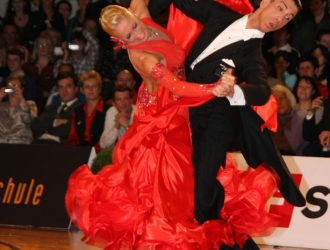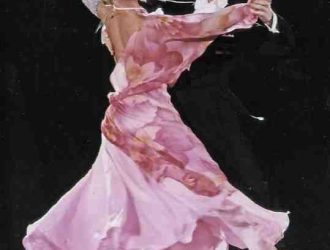Waltz
The waltz (from German: "Walzer") is a smooth, progressive ballroom and folk dance, normally in about this sound triple time, performed primarily in closed position.
Introduction#
The term “Waltz” originates from the old German word “walzen” which means to roll, turn, or to glide. Essentially this dance is all about gliding in a lively or conspicuous manner (to advance easily and successfully).
The Waltz is a ballroom dance in 3/4 time with a strong accent on the first beat and a basic pattern of step-step-close.
History#
The Waltz is a dance that was born in the suburbs of Vienna and in the alpine region of Austria. As early as the seventeenth century, Waltzes were played in the ballrooms of the Habsburg court, one of the most influential and distinguished royal houses of Europe.
The “weller”, or turning dances, were danced by peasants in Austria and Bavaria even before that time. Many of the familiar Waltz tunes can be traced back to simple peasant yodeling melodies.
During the middle of the eighteenth century, the Allemande form of the Waltz was very popular in France. Originally danced as one of the figures in the Contredanse, with arms intertwining at shoulder level, it soon became an independent dance and the close-hold was introduced. By the end of the eighteenth century, this old Austrian peasant dance had been accepted by high society, and the three-quarter rhythm was here to stay.
Strong Opposition#
However popular the Waltz, opposition was not lacking. Dancing masters saw the Waltz as a threat to the profession. The basic steps could be learned in relatively short time, whereas the Minuet and other court dances required considerable practice, not only to learn the many complex figures, but also to develop suitable postures and deportment.
The Waltz was also criticized on moral grounds by those opposed to its closer hold and rapid turning movements. Religious leaders almost unanimously regarded it as vulgar and sinful. Continental court circles held out obstinately against the dance. In England, (a land of strict morals), the Waltz was accepted even more slowly.
In July of 1816, the Waltz was included in a ball given in London by the Prince Regent. A blistering editorial in The Times a few days later stated:
“We remarked with pain that the indecent foreign dance called the Waltz was introduced (we believe for the first time) at the English court on Friday last … it is quite sufficient to cast one’s eyes on the voluptuous intertwining of the limbs and close compressure on the bodies in their dance, to see that it is indeed far removed from the modest reserve which has hitherto been considered distinctive of English females.
So long as this obscene display was confined to prostitutes and adulteresses, we did not think it deserving of notice; but now that it is attempted to be forced on the respectable classes of society by the civil examples of their superiors, we feel it a duty to warn every parent against exposing his daughter to so fatal a contagion.”
The Times of London, 16th July 1816
Even as late as 1866 an article in the English magazine Belgravia stated:
“We who go forth of nights and see without the slightest discomposure our sister and our wife seized on by a strange man and subjected to violent embraces and canterings round a small-sized apartment – the only apparent excuse for such treatment being that is done to the sound of music – can scarcely realize the horror which greeted the introduction of this wicked dance.”
A Slow Acceptance#
A lot of the disapproval was voiced by the older generation, but seldom mentioned is the fact the reigning Queen (Victoria) was a keen and expert Ballroom dancer with a special love of the Waltz!
But as history repeats itself over and over again, the antagonism only served to increase the popularity of the Waltz. The bourgeoisie took it up enthusiastically immediately after the French revolution. Paris alone had nearly seven hundred dance halls! A German traveler to Paris in 1804 stated, “This love for the Waltz and this adoption of the German dance is quite new and has become one of the vulgar fashions since the war, like smoking.”
Reportedly, the first time the Waltz was danced in the United States was in Boston in 1834. Lorenzo Papanti, a Boston dancing master, gave an exhibition in Mrs. Otis’ Beacon Hill mansion. Social leaders were aghast at what they called “an indecorous exhibition.” By the middle of the nineteenth century, the waltz was firmly established in United States society.
Music plays an important role in dance, and every dance is dependent upon the availability of the appropriate music. The waltz was given a tremendous boost around 1830 by two great Austrian composers – Franz Lanner and Johann Strauss. These two composers were by far the most popular during the nineteenth century: they set the standard for the Viennese Waltz, (a very fast version of the waltz).
By 1900, a typical dance program was three quarter waltzes and one quarter all other dances combined.
Around the close of the nineteenth century, two modifications of the waltz were developed. The first was the Boston, a slower waltz with long gliding steps. Although the Boston disappeared with the first world war, it did stimulate development of the English or International style which continues today. The second was the hesitation, which involves taking one step to three beats of the measure. Hesitation steps are still widely used in today’s waltz.
Fortunately, the violent opposition faded out and the Waltz weathered an exciting and varied career, emerging today in two accepted forms, both reflecting the main characteristics of the dance. They are known as the Modern Waltz and the Viennese (Quick) Waltz.
The Waltz: In – Depth#
There are several references to a sliding or gliding dance a waltz from the 16th century, including the representations of the printer H.S. Beheim. The French philosopher Montaigne wrote of a dance he saw in 1580 in Augsburg, where the dancers held each other so closely that their faces touched. Kunz Haas (of approximately the same period) wrote, “Now they are dancing the godless Weller or Spinner.” “The vigorous peasant dancer, following an instinctive knowledge of the weight of fall, utilizes his surplus energy to press all his strength into the proper beat of the measure, thus intensifying his personal enjoyment in dancing”.
The peasants of Bavaria, Tyrol, and Styria began dancing a dance called Walzer, a dance for couples, around 1750. The Ländler, also known as the Schleifer, a country dance in 3/4 time, was popular in Bohemia, Austria, and Bavaria, and spread from the countryside to the suburbs of the city. While the eighteenth century upper classes continued to dance the minuet, bored noblemen slipped away to the balls of their servants.
In the 1771 German novel Geschichte des Fräuleins von Sternheim by Sophie von La Roche, a high-minded character complains about the newly introduced waltz among aristocrats thus: “But when he put his arm around her, pressed her to his breast, cavorted with her in the shameless, indecent whirling-dance of the Germans and engaged in a familiarity that broke all the bounds of good breeding then my silent misery turned into burning rage.”
Describing life in Vienna (dated at either 1776 or 1786[5]), Don Curzio wrote, “The people were dancing mad The ladies of Vienna are particularly celebrated for their grace and movements of waltzing of which they never tire.” There is a waltz in the second act finale of the opera “Una Cosa Rara” written by Martin y Soler in 1786. Soler’s waltz was marked Andante con moto, or “at a walking pace with motion”, but the flow of the dance was sped-up in Vienna leading to the Geschwindwalzer, and the Galloppwalzer.
In the transition from country to town, the hopping of the Ländler, a dance known as Langaus, became a sliding step, and gliding rotation replaced stamping rotation.
In the 19th century, the word primarily indicated that the dance was a turning one; one would waltz in the polka to indicate rotating rather than going straight forward without turning.
The Viennese custom is to slightly anticipate the second beat of each measure, making it sound as if the third is late and creating a certain buoyancy. The younger Strauss (Johann Strauss II) would sometimes break up the one-two-three of the melody with a one-two pattern in the accompaniment along with other rhythms, maintaining the 3/4 time while causing the dancers to dance a two-step waltz. The metronome speed for a full bar varies between 60 and 70, with the waltzes of the first Strauss (Johann Strauss I) often played faster than those of his sons.
Shocking many when it was first introduced, the waltz became fashionable in Vienna around the 1780s, spreading to many other countries in the years to follow. It became fashionable in Britain during the Regency period, having been made respectable by the endorsement of Dorothea Lieven, wife of the Russian ambassador. Diarist Thomas Raikes later recounted that “No event ever produced so great a sensation in English society as the introduction of the waltz in 1813.” In the same year, a sardonic tribute to the dance by Lord Byron was anonymously published (written the previous autumn). Influential dance master and author of instruction manuals, Thomas Wilson published A Description of the Correct Method of Waltzing in 1816.[14] Almack’s, the most exclusive club in London, permitted the waltz though the entry in the Oxford English Dictionary shows that it was considered “riotous and indecent” as late as 1825. The waltz, and especially its closed position, became the example for the creation of many other ballroom dances. Subsequently, new types of waltz have developed, including many folk and several ballroom dance.
Variations & Styles#
In the 19th and early 20th centuries, numerous different Waltz forms existed, including versions performed in 3/4, 3/8 or 6/8 (Sauteuse Waltz), and 5/4 time.
Hesitation Walt#
In the 1910s, a form called the Hesitation Walt was introduced by Vernon and Irene Castle. It incorporated “hesitations” and was danced to fast music. A hesitation is basically a halt on the standing foot during the full Waltz measure, with the moving foot suspended in the air or slowly dragged. Similar figures such as the Hesitation Change, Drag Hesitation, and Cross Hesitation are incorporated in the International Style Standard Waltz Syllabus.
Country Western Waltz#
The Country Western Waltz is mostly progressive, moving counter clock wise around the dance floor. Both the posture and frame are relaxed, with posture bordering on a slouch. The exaggerated hand and arm gestures of some Ballroom styles are not part of this style. Couples may frequently dance in the promenade position, depending on local preferences. Within Country Western waltz, there is the Spanish Waltz and the more modern (for the late 1930s- early 1950s) Pursuit Waltz. At one time it was considered ill treatment for a man to make the woman walk backwards in some locations.
Spanish Waltz#
In California the waltz was banned by Mission priests until after 1834 because of the “closed” dance position. Thereafter a Spanish Waltz was danced. This Spanish Waltz was a combination of dancing around the room in closed position, and a “formation” dance of two couples facing each other and performing a sequence of steps. “Valse a Trois Temps” was the “earliest” waltz step, and the Rye Waltz was favored as a couple dance.
Irish Waltz#
In traditional Irish music, the Waltz was taught by traveling dancing masters to those who could afford their lessons during the 19th century. By the end of that century, the dance spread to the middle and lower classes of Irish society and traditional triple-tune tunes and songs were altered to fit the Waltz rhythm. During the 20th century, the Waltz found a distinctively Irish playing style in the hands of Céilidh musicians at dances.
Scandinavian Waltz#
The Scandinavian Waltz, performed as a part of Scandinavian folk dance, can be fast or slow, but the dancers are always rotating.
Peruvian Waltz#
- The Peruvian Waltz is called and recognized in Peru as vals criollo
Mexican Waltz#
- The Mexican Waltz (vals mexicano) follows the same basic rhythmic pattern as the standard waltz, but the melodies reflect a strong Spanish influence. Mexico’s Juventino Rosas wrote “Sobre las Olas” or “Over the Waves”, commonly known in the U.S. as a circus song played during a trapeze show.
Cajun Waltz#
- The Cajun Waltz is danced progressively around the floor, and is characterized by the subtle swaying of the hips and step very close to ordinary walking. It is danced entirely in the closed position.
Cuban (or Tropical) Waltz#
- The Cuban (or Tropical) Waltz follows the pattern of the standard waltz throughout the song.
Venezuelan waltz#
- The Venezuelan waltz provided a basis for distinctive regional musical composition.
Contra Waltz (Freeform Waltz)#
- The Contra Waltz (Freeform Waltz), included in most contra dance evenings, uses both open and closed positions, and incorporates moves from other dances such as swing, modern jive and salsa. Basically the dancers progress around the dance floor with a waltz step, but with no constraints on what moves they can use.
Valse Musette#
- The Valse Musette, a form of waltz popular in France, started in the late 19th century.
cross-step waltz (French Valse Boston)#
- The cross-step waltz (French Valse Boston) developed in France in the early 20th century and is popular in social waltz groups today.
Folk Dance – Alsace, France#
- In folk dance from the Alsace region, waltzes in odd metres such as 5/4, 8/4 and 11/4 are found. In modern bal folk, waltzes in even higher metres are played and danced.
Labajalavalss (Flat-Foot Waltz)#
- Estonian folk dance Labajalavalss (flat of the foot waltz) performed in 3/4 time.
The Waltz Today#
Today both the faster Viennese Waltz, made forever popular by the Strauss family, and the slower American and International style waltzes are extremely popular with dancers of all ages.
International Style Standard#
- In contemporary Ballroom Dancing, the fast version of the Waltz is known as the Viennese Waltz as opposed to the Slow Waltz which we have come to know as the International Style Standard Waltz.
- The International Style Standard Waltz has only closed figures; that is, the couple never breaks the embrace.
American Style#
- The American Style Waltz, part of the American Smooth Ballroom Dancing syllabus, in contrast to the International Style Standard Waltz, involves breaking contact almost entirely in some figures. For example, the Syncopated Side-by-Side with Spin includes a free spin for both partners. Open rolls are another good example of an open dance figure, in which the follower alternates between the lead’s left and right sides, with the lead’s left or right arm (alone) providing the lead. Waltzes were the staple of many American musicals and films, including “Waltz in Swing Time” sung by Fred Astaire.




